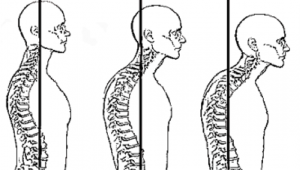By: Trevor Johnson, SPT
 When a headache strikes, it’s easy to reach for the aspirin and focus on making the pain disappear. But taking a few minutes to understand some common causes of a headache might help you avoid feeling discomfort in the first place.
When a headache strikes, it’s easy to reach for the aspirin and focus on making the pain disappear. But taking a few minutes to understand some common causes of a headache might help you avoid feeling discomfort in the first place.
Headaches (HA) are common in 47% of the population, with 15-20% being caused by postural dysfunction in the neck (cervicogenic); and 44% of people with cervicogenic HAs have jaw pain.1 Forward head posture (FHP) is an epidemic that is common in about 66-90% of today’s population and is a contributing factor to both HAs and jaw pain, also known as Temporomandibular joint (TMJ) pain.2 The simplest definition of FHP is when the head position is ahead of the shoulders, changing the center of gravity, and placing increased tension on the neck and associated structures of the head (see picture below).3
FHP results in upper cervical (neck) extension to maintain a level line of vision, thereby shortening the posterior cervical muscles.3, 4 This increased tension may result in repeated pain stimulus into the trigeminal nerve nucleus (face and jaw nerve), thereby lowering the pain threshold and resulting in increased incidence of headaches (see image below).4 Additionally, FHP changes the position of the jaw, thus increasing the amount the muscles must work to open and close the mouth, causing pain.5
Common Causes of FHP are associated with:1
- Injury and/or muscle guarding
- Disease and nutritional state
- Muscle tension and/or muscle weakness
- Stress
- Genetics
- Improper shoes
- Occupation that involves sitting for long periods of time
- Bad habits that precipitate into long-term problems
A physical therapist can help you reduce symptoms associated with headaches and Temporomandibular dysfunction (TMD) by teaching you how to: 6
- Improve neck mobility
- Improve strength
- Improve posture
- Modify your home or work environment
For more information on how physical therapists can help improve forward head posture that may be related to headache or jaw pain visit:
Physical Therapist’s Guide to Headaches
See related Sports PT blog titled “Physical Therapy Can Help Chronic Jaw Pain”
References:
1 Asher, A. (2007) Causes of Poor Posture. Retrieved on 27 March 2014 from http://backandneck.about.com/od/medication/tp/poorposture.htm.
2 Chiropractors’ Association of Australia. (2012) Retrieved 25 March 2014 from http://whatsyourposture.com.au/posture-health/posture-problems/forward-head-posture/.
3 Fernandez-De-Las-Penas, C, Perez-De-Heredia, M, Molero-Sanchez, A, & Miangolarra-Page, JC. (2007). Performance of the Craniocervical Flexion Test, Forward Head Posture, and Headache Clinical Parameters in Patients With Chronic Tension-Type Headache: A Pilot Study. Journal of Orthopaedic & Sports Physical Therapy, 37(2), 33-39. doi: 10.2519/jospt.2007.2401
4 Fernandez-de-las-Penas C, Alonso-Blanco C, Cuadrado ML, Gerwin RD, Pareja JA. Trigger points in the suboccipital muscles and forward head posture in tension-type headache. Headache. 2006;46:454-460.
5 Furto, E. (2014) Physical Therapists Guide to Temporomandibular Disorder. American Physical Therapy Association. Retrieved on 27 March 2014 from http://www.moveforwardpt.com/symptomsconditionsdetail.aspx?cid=0cb55ce4-d260-4887-ad29-d8cb18e0b91e#.UzTEP2dOXIU
6 Furto, ES. (2014) Physical Therapists Guide to Headaches. American Physical Therapy Association. Retrieved on 27 March 2014 from http://www.moveforwardpt.com/resources/detail.aspx?cid=fd8a18c8-1893-4dd3-9f00-b6e49cad5005#.UzTDyWdOXIU
Sports PT is proud to invest in teaching and mentoring students of physical therapy throughout New York State. To learn more about the student experience, visit: /Students/overview.aspx










